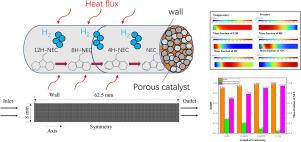Numerical Study of dehydrogenation of dodecahydro-N-ethylcarbazole in fixed bed reactor based on the porous medium approach
IF 3.9
3区 工程技术
Q3 ENERGY & FUELS
Chemical Engineering and Processing - Process Intensification
Pub Date : 2025-08-05
DOI:10.1016/j.cep.2025.110481
引用次数: 0
Abstract
Liquid Organic Hydrogen Carriers (LOHC) technology shows promise for hydrogen storage and transportation technology. However, it encounters challenges in fixed bed reactors, especially the inefficient heat transfer during the dehydrogenation process. Computational Fluid Dynamics (CFD) can be used to analyze the interaction of multi-physical fields in the reactor. In this study, a two-dimensional axisymmetric porous medium model of the fixed bed reactor was established to explore the dehydrogenation reaction performance of the liquid organic hydrogen carrier system N-ethylcarbazole(NEC). We studied the effects of key parameters such as wall temperature, inlet LOHC velocity, inlet LOHC temperature, porosity, thermal conductivity of wall and length of reactor to optimize reactor performance. Meanwhile, the content changes of intermediate components and the axial and radial temperature distributions were studied. The results indicate that inlet LOHC temperature, bed porosity and thermal conductivity of wall have no significant influence on the degree of dehydrogenation. Under the condition of wall temperature of 473 K, inlet velocity of 0.026 mm/s and 0.125 m in length, the obtained degree of dehydrogenation is 0.9853, which facilitate both high heat transfer rate and good reactor performance. This study can provide a basis for researching the heat transfer mechanism and designing and optimizing the reactor.

基于多孔介质方法的十二氢- n -乙基咔唑固定床反应器脱氢数值研究
液态有机氢载体(LOHC)技术在氢储存和运输技术方面具有广阔的前景。但在固定床反应器中遇到了挑战,特别是脱氢过程中的传热效率低下。计算流体力学(CFD)可以用于分析反应器中多物理场的相互作用。本研究建立了固定床反应器的二维轴对称多孔介质模型,探讨了液态有机载氢体系n -乙基咔唑(NEC)的脱氢反应性能。为了优化反应器性能,研究了壁温、入口LOHC速度、入口LOHC温度、孔隙率、壁热导率和反应器长度等关键参数对反应器性能的影响。同时,对中间组分含量变化及轴向和径向温度分布进行了研究。结果表明:进口LOHC温度、床层孔隙度和壁面导热系数对脱氢程度影响不显著;在壁温为473 K、入口速度为0.026 mm/s、入口长度为0.125 m的条件下,得到的脱氢度为0.9853,传热率高,反应器性能好。该研究可为研究反应器的传热机理和设计优化提供依据。
本文章由计算机程序翻译,如有差异,请以英文原文为准。
求助全文
约1分钟内获得全文
求助全文
来源期刊
CiteScore
7.80
自引率
9.30%
发文量
408
审稿时长
49 days
期刊介绍:
Chemical Engineering and Processing: Process Intensification is intended for practicing researchers in industry and academia, working in the field of Process Engineering and related to the subject of Process Intensification.Articles published in the Journal demonstrate how novel discoveries, developments and theories in the field of Process Engineering and in particular Process Intensification may be used for analysis and design of innovative equipment and processing methods with substantially improved sustainability, efficiency and environmental performance.

 求助内容:
求助内容: 应助结果提醒方式:
应助结果提醒方式:


